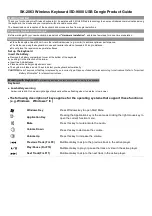
P-250
77
Other Settings [OTHER SETTING]
Edit Operation
■
Selecting a scale [Scale]
The P-250 enables you to select various scales. Equal
Temperament is the most common contemporary piano
tuning scale. However, history has known numerous
other scales, many of which serve as the basis for certain
genres of music. You can experience the tunings of these
genres.
Press the D [–]/[+] buttons to select from the scales
below.
Equal
One octave is divided into twelve equal intervals. This is
currently the most popular piano tuning scale.
PureMajor/PureMinor
Based on natural overtones, three major chords using
these scales produce a beautiful, pure sound. They are
sometimes used for chorus parts.
Pythagorean
This scale, designed by Pythagoras, a Greek philosopher,
is composed of only five pitches. The 3rd produces
swells, but the 4th and 5th are beautiful and suitable for
some leads.
MeanTone
This scale is an improvement on the Pythagorean scale
in that the swell of the 3rd has been eliminated. It
became popular during the late 16th century through the
late 18th century. Handel used this scale.
WerckMeister/KirnBerger
These scales combine Mean Tone and Pythagorean in
different ways. With these scales, modulation changes
the impression and feel of the songs. These scales were
often used in the era of Bach and Beethoven. They are
also often used now to reproduce the music of that era
on harpsichords.
If you select a scale other than Equal, you need to specify
the root note. Press the B [–(NO)]/[+(YES)] buttons to
select from C, C
, D, E
, E, F, F
, G, A
, A, B
, or B.
[Scale] is a performance parameter (page 30).
■
Setting the split point [SplitPoint]
Set the split point on the keyboard that separates the
right and left-hand sections.
Press the D [–]/[+] buttons to set the value (A-1 — C7).
[SplitPoint] is a performance parameter (page 30).
■
Setting the key [Transpose]
The P-250’s Transpose function makes it possible to shift
the pitch of the entire keyboard up or down in semitone
intervals to facilitate playing in difficult key signatures,
and to let you easily match the pitch of the keyboard to
the range of a singer or other instruments.
For example, if you set the transposition amount to “5,”
playing key C produces pitch F. In this way, you can play
the song as if it were in C major, and the P-250 will
transpose it to the key of F.
Press the C [–]/[+] buttons to select one of the following
to transpose:
Master
..........Any sound of the instrument (actual play-
ing, playback song)
Keyboard
......Actual playing
Song
.............Playback song
Press the D [–]/[+] buttons to set the transposition
amount from –12 (–1 octave) to 0 (standard pitch) to +12
(+1 octave).
[Transpose] is a performance parameter (page 30).
■
Specifying the depth of the soft pedal [Soft-
PedalDepth]
Press the D [–]/[+] buttons to set the value (1—10).
[SoftPedalDepth] is a performance parameter (page
30).
■
Specifying the depth of string resonance
[StringResonanceDepth]
This parameter is effective on the voice group
GRANDPIANO1.
Press the D [–]/[+] buttons to set the value (Off, 1—10).
[StringResonanceDepth] is a performance parameter
(page 30).
• Refer to page 61 for general information on setting the parameters.
• Refer to pages 3—5 of the separate “Data List” for information on the
default parameter settings.
Summary of Contents for P-250
Page 56: ...MEMO 56 P 250 Edit Operation ...
Page 80: ...MEMO 80 P 250 Appendix ...















































